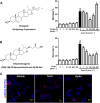Dihydrodiosgenin protects against experimental acute pancreatitis and associated lung injury through mitochondrial protection and PI3Kγ/Akt inhibition
- PMID: 29457828
- PMCID: PMC5913405
- DOI: 10.1111/bph.14169
Dihydrodiosgenin protects against experimental acute pancreatitis and associated lung injury through mitochondrial protection and PI3Kγ/Akt inhibition
Abstract
Background and purpose: Acute pancreatitis (AP) is a painful and distressing disorder of the exocrine pancreas with no specific treatment. Diosgenyl saponins extracted from from Dioscorea zingiberensis C. H. Wright have been reported to protect against experimental models of AP. Diosgenin, or its derivatives are anti-inflammatory in various conditions. However, the effects of diosgenin and its spiroacetal ring opened analogue, dihydrodiosgenin (Dydio), on AP have not been determined.
Experimental approach: Effects of diosgenin and Dydio on sodium taurocholate hydrate (Tauro)-induced necrosis were tested, using freshly isolated murine pancreatic acinar cells. Effects of Dydio on mitochondrial dysfunction in response to Tauro, cholecystokinin-8 and palmitoleic acid ethyl ester were also assessed. Dydio (5 or 10 mg·kg-1 ) was administered after the induction in vivo of Tauro-induced AP (Wistar rats), caerulein-induced AP and palmitoleic acid plus ethanol-induced AP (Balb/c mice). Pancreatitis was assessed biochemically and histologically. Activation of pancreatic PI3Kγ/Akt was measured by immunoblotting.
Key results: Dydio inhibited Tauro-induced activation of the necrotic cell death pathway and prevented pancreatitis stimuli-induced mitochondrial dysfunction. Therapeutic administration of Dydio ameliorated biochemical and histopathological responses in all three models of AP through pancreatic mitochondrial protection and PI3Kγ/Akt inactivation. Moreover, Dydio improved pancreatitis-associated acute lung injury through preventing excessive inflammatory responses.
Conclusion and implications: These data provide in vitro and in vivo mechanistic evidence that the diosgenin analogue, Dydio could be potential treatment for AP. Further medicinal optimization of diosgenin and its analogue might be a useful strategy for identifying lead candidates for inflammatory diseases.
© 2018 The British Pharmacological Society.
Figures







References
-
- Aquila S, Sisci D, Gentile M, Middea E, Catalano S, Carpino A et al (2004). Estrogen receptor (ER) α and ERβ are both expressed in human ejaculated spermatozoa: evidence of their direct interaction with phosphatidylinositol‐3‐OH kinase/Akt pathway. J Clin Endocrinol Metabol 89: 1443–1451. - PubMed
-
- Awla D, Zetterqvist AV, Abdulla A, Camello C, Berglund LM, Spégel P et al (2012). NFATc3 regulates trypsinogen activation, neutrophil recruitment, and tissue damage in acute pancreatitis in mice. Gastroenterology 143: 1–7. - PubMed
Publication types
MeSH terms
Substances
LinkOut - more resources
Full Text Sources
Other Literature Sources
Medical

